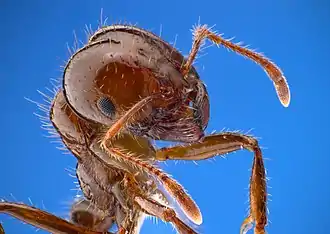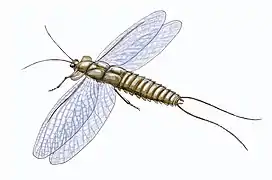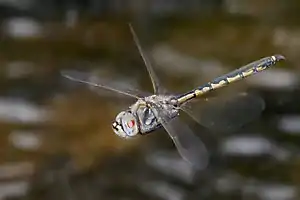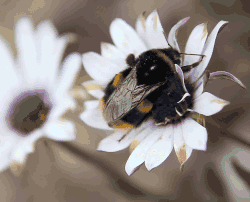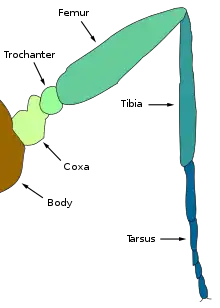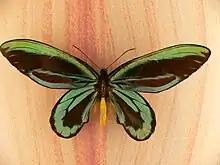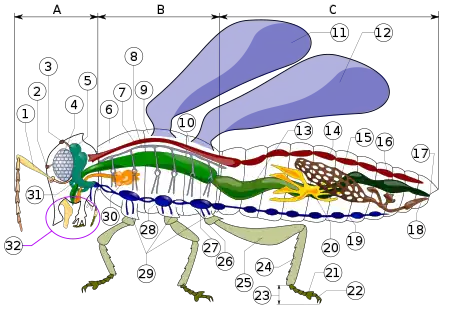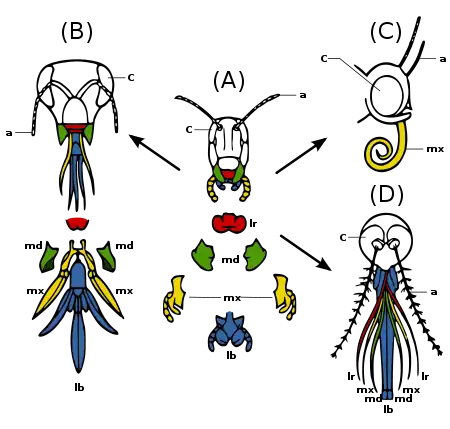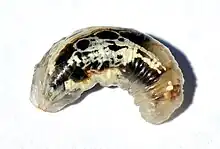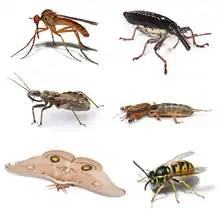Portal:Insects
The Insects Portal

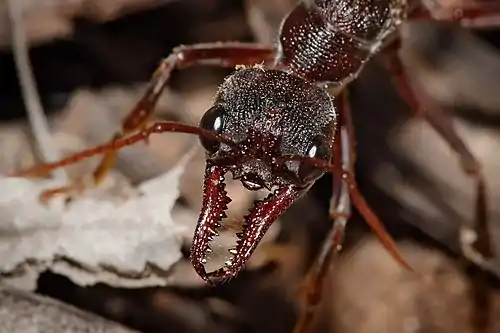
Insects (from Latin insectum) are pancrustacean hexapod invertebrates of the class Insecta. They are the largest group within the arthropod phylum. Insects have a chitinous exoskeleton, a three-part body (head, thorax and abdomen), three pairs of jointed legs, compound eyes and one pair of antennae. Their blood is not totally contained in vessels; some circulates in an open cavity known as the haemocoel. Insects are the most diverse group of animals; they include more than a million described species and represent more than half of all known living organisms. The total number of extant species is estimated at between six and ten million; potentially over 90% of the animal life forms on Earth are insects. (Full article...)
Selected article -
The red imported fire ant (Solenopsis invicta), also known as the fire ant or RIFA, is a species of ant native to South America. A member of the genus Solenopsis in the subfamily Myrmicinae, it was described by Swiss entomologist Felix Santschi as a variant of S. saevissima in 1916. Its current specific name invicta was given to the ant in 1972 as a separate species. However, the variant and species were the same ant, and the name was preserved due to its wide use. Though South American in origin, the red imported fire ant has been accidentally introduced in Australia, New Zealand, several Asian and Caribbean countries, Europe and the United States. The red imported fire ant is polymorphic, as workers appear in different shapes and sizes. The ant's colours are red and somewhat yellowish with a brown or black gaster, but males are completely black. Red imported fire ants are dominant in altered areas and live in a wide variety of habitats. They can be found in rainforests, disturbed areas, deserts, grasslands, alongside roads and buildings, and in electrical equipment. Colonies form large mounds constructed from soil with no visible entrances because foraging tunnels are built and workers emerge far away from the nest.
These ants exhibit a wide variety of behaviours, such as building rafts when they sense that water levels are rising. They also show necrophoric behaviour, where nestmates discard scraps or dead ants on refuse piles outside the nest. Foraging takes place on warm or hot days, although they may remain outside at night. Workers communicate by a series of semiochemicals and pheromones, which are used for recruitment, foraging, and defence. They are omnivores and eat dead mammals, arthropods, insects, seeds, and sweet substances such as honeydew from hemipteran insects with which they have developed relationships. Predators include arachnids, birds, and many insects including other ants, dragonflies, earwigs, and beetles. The ant is a host to parasites and to a number of pathogens, nematodes, and viruses, which have been viewed as potential biological control agents. Nuptial flight occurs during the warm seasons, and the alates may mate for as long as 30 minutes. Colony founding can be done by a single queen or a group of queens, which later contest for dominance once the first workers emerge. Workers can live for several months, while queens can live for years; colony numbers can vary from 100,000 to 250,000 individuals. Two forms of society in the red imported fire ant exist: polygynous colonies (nests with multiple queens) and monogynous colonies (nests with one queen). (Full article...)Did you know -
- ... that of the three described species in the Eocene bulldog ant genus Avitomyrmex, one species is known only from worker caste individuals?
- ... that one species of the extinct Eocene bulldog ant Ypresiomyrma reached up to 25 millimetres (0.98 in) in length?
- ... that the type specimen of the extinct bulldog ant Macabeemyrma ovata is the fossilized remains of an adult queen preserved in shale?
- ... that the type specimen of the extinct tortoise beetle Denaeaspis is only 6.04 millimetres (0.238 in) long?
- ... that the extinct snakefly Agulla protomaculata is the only snakefly described from the Green River Formation?
List articles
- List of largest insects
- List of data deficient insects
- List of least concern insects
- List of near threatened insects
- List of vulnerable insects
- List of endangered insects
- List of critically endangered insects
Related portals
General images -
Selected image -

The rose chafer Cetonia aurata (Coleoptera: Scarabaeidae) is a beetle, 20 mm (¾ in) long, that has metallic green coloration.
Topics
Subcategories
WikiProjects
Main WikiProject:
- WikiProject Insects
Related projects:
- WikiProject Arthropods
- WikiProject Spiders
- WikiProject Animals
- WikiProject Tree of Life
- WikiProject Biology
Daughter projects:
- WikiProject Lepidoptera
Tasks
 |
Here are some tasks awaiting attention:
|
Associated Wikimedia
The following Wikimedia Foundation sister projects provide more on this subject:
-
 Commons
Commons
Free media repository -
 Wikibooks
Wikibooks
Free textbooks and manuals -
 Wikidata
Wikidata
Free knowledge base -
 Wikinews
Wikinews
Free-content news -
 Wikiquote
Wikiquote
Collection of quotations -
 Wikisource
Wikisource
Free-content library -
 Wikiversity
Wikiversity
Free learning tools -
 Wiktionary
Wiktionary
Dictionary and thesaurus
-
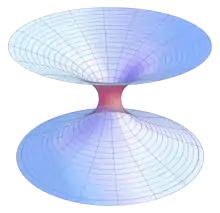 List of all portalsList of all portals
List of all portalsList of all portals -
 The arts portal
The arts portal -
 Biography portal
Biography portal -
 Current events portal
Current events portal -
 Geography portal
Geography portal -
 History portal
History portal -
 Mathematics portal
Mathematics portal -
 Science portal
Science portal -
 Society portal
Society portal -
 Technology portal
Technology portal -
 Random portalRandom portal
Random portalRandom portal -
 WikiProject PortalsWikiProject Portals
WikiProject PortalsWikiProject Portals
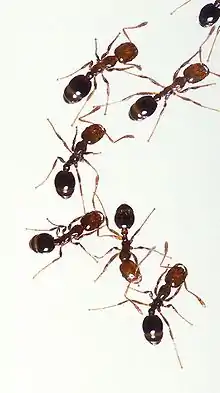
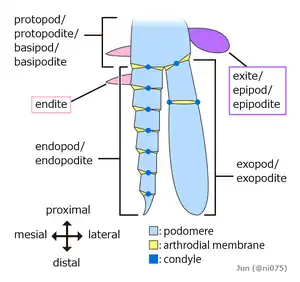
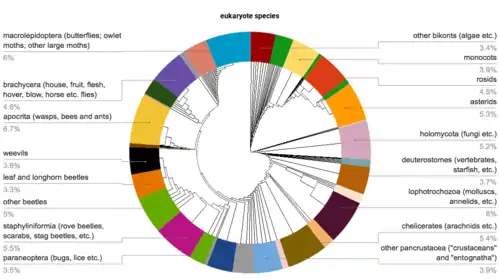


.jpg.webp)

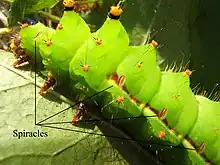


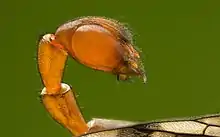
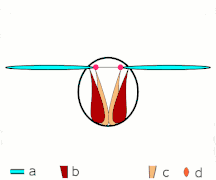
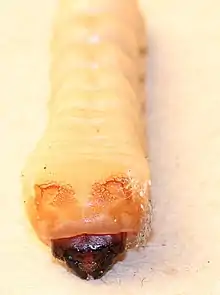
.jpg.webp)
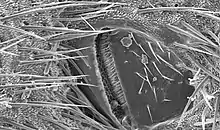
.png.webp)
